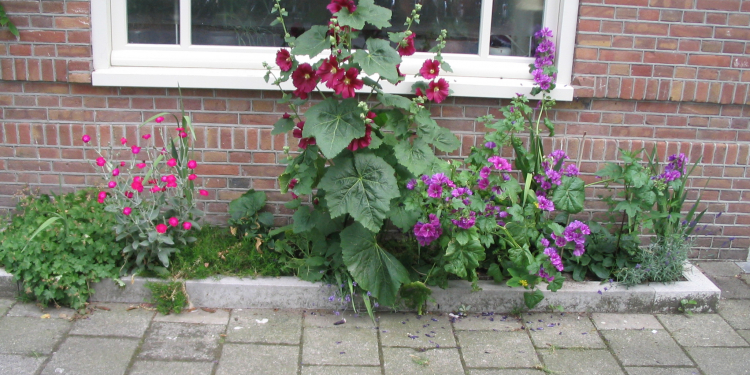
Pavement gardens

Plants can do wonders for house facades, and can even make entire streets more beautiful. Do you want to make your street greener, but don’t have a front garden? One solution is a pavement or sidewalk garden (‘geveltuin’). All it takes is the removal of a few paving stones in front of your house, replacing the sand with soil, and you can start planting. You can read here about how to create your own little garden in front of your door.
What is a pavement garden?
A pavement garden is a plot of green in front of your home. The city district (‘stadsdeel’) will come lay a strip of earth along the facade of your house (with the exception of your front door!) The garden will be one-and-a-half paving tiles deep. You can fill the garden with your choice of colourful, evergreen or flowering plants. You don’t have to live on the ground floor of your building to apply for a sidewalk garden, although you do need the permission of the owner or first-floor occupant. The pavement garden will definitely brighten up the shared entrance to the building.
What is involved?
If your application for a pavement garden in Amsterdam South is successful, you will become the caretaker of a piece of public space that is the property of the city district. The city district office will help you get started by removing the paving stones and delivering soil. You are responsible for arranging and taking care of the plants. There are a few conditions: the sidewalk must be accessible (no overhanging branches), you may not plant trees in your garden and the building facade must not be damaged. Additional rules of the game are further explained in the application form below (which is in Dutch).
What are the benefits of pavement gardens?
Sidewalk gardens contribute to a pleasant living environment, particularly if there is little green in the area. But every garden, no matter how small, also requires maintenance. We can think of a number of reasons why you might want a pavement garden, including:
- More green in the neighbourhood brings people together, and creates extra room for nature. It is also an easy way to get to know your neighbours. Maybe they even want to help out!
- Research shows that living amongst green is good for peoples’ health: people exposed to nature feel better in general and are less frequently sick.
- Plants also contribute to making an area more inviting and more colourful.
- Your pavement garden will increase biodiversity in the neighbourhood by attracting small animals, butterflies, and birds. Don’t worry about attracting extra insects, as birds will happily gobble them up for you in your new mini-ecosystem.
- In-ground plants need to be watered less frequently than potted plants.
- By replacing the concrete tiles along your street-side facade with a garden, you enable rainwater streaming off the roof to be absorbed into the ground. If needed, you can disconnect your drainpipe when constructing your pavement garden. The condition is that it must be possible to guide excess rainwater to the closest source of surface water (for example a river, canal or pond), or into the gutter.
You can request a sidewalk garden from the Amsterdam South city district office at any time during the year. Fill in the digital application form and upload a sketch of where you want the garden to be placed.
Construction and maintenance
The district sidewalk pavers will come to construct your garden. It is unfortunately not possible to make an appointment for the construction work. The workers’ time, the materials and the soil are paid by the city district. They will dig up the sand and replace it with soil so that you can start to plant immediately. Once the garden is in place, it is up to you to make something beautiful out of it. Download our useful tips for the construction and maintenance of your pavement garden.